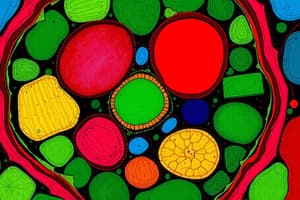Podcast
Questions and Answers
What is the function of the cell wall in plant cells?
What is the function of the cell wall in plant cells?
- Protein synthesis
- Facilitates cell division
- Mechanical protection (correct)
- Energy storage
What is the main component of the cell wall in plant cells?
What is the main component of the cell wall in plant cells?
- Pectin
- Hemicellulose
- Cellulose (correct)
- Lignin
What is the role of lignin in the cell wall of plant cells?
What is the role of lignin in the cell wall of plant cells?
- Forms long fibers
- Adds rigidity to the cell wall (correct)
- Provides energy for cellular processes
- Provides mechanical protection
Which carbohydrate forms a network along with structural proteins to form the cell wall in plant cells?
Which carbohydrate forms a network along with structural proteins to form the cell wall in plant cells?
Apart from plant cells, in which other organisms is the cell wall present?
Apart from plant cells, in which other organisms is the cell wall present?
What is the main component of bacterial cell walls?
What is the main component of bacterial cell walls?
Which organisms have cell walls similar to those of plants?
Which organisms have cell walls similar to those of plants?
What is the primary function of the cell wall in plant cells?
What is the primary function of the cell wall in plant cells?
Which organisms have the cell wall as a crucial component?
Which organisms have the cell wall as a crucial component?
What does the cell wall provide for the exchange of molecules with the environment?
What does the cell wall provide for the exchange of molecules with the environment?
Study Notes
Cell Wall in Biology
The cell wall is a specialized form of extracellular matrix that surrounds every cell of a plant and is responsible for various functions upon which plant life depends. It is present in plant cells, fungi, bacteria, algae, and some archaea. The cell wall provides mechanical protection, a chemically buffered environment, and a porous medium for the circulation and distribution of water, minerals, and other small nutrient molecules. It also gives the cell its shape, allows the organism to maintain a certain shape overall, and provides protection from pathogens such as bacteria and fungi.
Structure of Cell Wall
The cell wall is composed of various materials, depending on the type of organism. In plant cells, the main component of the cell wall is cellulose, a carbohydrate that forms long fibers and gives the cell wall its rigidity. Cellulose fibers group together to form bundles called microfibrils. Other important carbohydrates in plant cell walls include hemicellulose, pectin, and ligninin. These carbohydrates form a network along with structural proteins to form the cell wall.
Composition of Cell Wall
Cell walls differ in composition depending on the organism. For example:
- Plant cell walls are mainly composed of cellulose, hemicellulose, pectin, and lignin.
- Bacterial cell walls are made up of peptidoglycan, which is composed of sugars and amino acids.
- Fungal cell walls lack cellulose and are composed of chitin.
- Algal cell walls are similar to those of plants and many contain specific polysaccharides useful for taxonomy.
Cell Wall in Different Organisms
The cell wall is present in various organisms, such as plants, fungi, bacteria, algae, and some archaea. While the cell wall is present only in plants and some fungi, bacteria, and algae.
Functions of Cell Wall
The cell wall serves several essential functions in plant cells and other organisms, including:
- Providing structural strength and support.
- Giving the cell its shape and rigidity.
- Protecting the cell from physical damage.
- Providing a semi-permeable surface for molecules to pass in and out of the cell.
- Sensing the presence of pathogenic organisms and responding to environmental stresses.
In summary, the cell wall is a crucial component of plant cells and other organisms, providing structure, support, and protection while allowing for the exchange of molecules with the environment.
Studying That Suits You
Use AI to generate personalized quizzes and flashcards to suit your learning preferences.
Description
This quiz covers the structure, composition, and functions of the cell wall in various organisms, including plants, fungi, bacteria, algae, and some archaea. It discusses the materials that make up the cell wall, its role in providing mechanical protection and a porous medium for nutrient circulation, and its importance in maintaining cell shape and protecting from pathogens.



